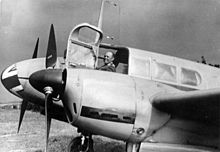Siebel Flugzeugwerke
| Siebel Flugzeugwerke KG | |
|---|---|
| legal form | Limited partnership |
| founding | 1937 (takeover of Klemm-Flugzeugwerke Halle, founded in 1934 ) |
| resolution | October 1946 |
| Reason for dissolution | Dismantling of the plant and moving the entire workforce to Dubna (-Podberesje) as part of the Ossawakim campaign |
| Seat | Halle (Saale) , Germany |
| management | Friedrich Siebel (General Director) |
| Branch | Aircraft manufacturer |
The Siebel Flugzeugwerke KG in Halle (Saale) emerged from the 1934 founded Klemm aircraft factory hall (branch factory of light aircraft terminal in Böblingen forth), which in December 1937 by Friedrich Siebel were taken. It was located west of Mötzlich in the Boelcke road 70 (now Dessauer Str 70 (. 51 ° 30 '42.4 " N , 11 ° 59' 39.6" O )), a road that from 1939 to 1945 for public traffic was blocked.
The beginnings
The Siebel plants built mainly travel and commercial aircraft of their own design as well as under license Nahaufklärer Heinkel He 46 , trainer aircraft Focke-Wulf Fw 44 "Stieglitz" and bomber / reconnaissance aircraft Dornier Do 17 M / P and Junkers Ju 88 . The best known of their own types were the Fh / Si 204 and the Si 202 , also known as the "Hummel" . From 1944 onwards, the plant was working on the experimental construction of the DFS 346 supersonic aircraft with wings swept back 45 degrees and rocket propulsion .
At the same time prisoners from Poland, the Czech Republic, the USSR, France, the Netherlands and other nations were used in the Birkhahn subcamp , a subcamp of the Buchenwald concentration camp , for forced labor at the Siebel works. On July 7 and August 16, 1944, and on March 30, 1945, the United States Army Air Forces carried out air raids on the plant.
After Halle (Saale) belonged to the Soviet occupation zone from July 1945 after initially American occupation , work was carried out on the further development of the DSF 346.
Development after the war
In October 1946 the plant was dismantled and the entire workforce and their families, as far as they could, were moved to Dubna (-Podberesje) , about 120 kilometers north of Moscow , as part of the Ossawakim campaign . In the so-called design office OKB 2 , work continued under graduate engineer Heinz (Heinrich) Rössing. In the fall of 1950 the first "Siebelaner" were allowed to return to Germany.
Together with a business partner, Friedrich Siebel founded another company in Munich in 1948 to manufacture and sell foreign sport and commercial aircraft, the Siebel Flugzeugwerke ATG (SIAT). The company headquarters was relocated to Donauwörth in 1956 and WMD Siebelwerke ATG (WMD / SIAT) was created in 1958 in cooperation with Waggon- und Maschinenbau GmbH Donauwörth (WMD). This marked the beginning of the return to aircraft construction with orders for the production of large parts. The company later played a key role in many aircraft projects in the post-war period.
After Bölkow GmbH had acquired the majority in the company, it was fully integrated into the group in 1968 as part of the merger to form Messerschmitt-Bölkow GmbH .
Buildings in Halle
The buildings of the Siebel aircraft works in Halle were designed by the architect Lois Welzenbacher with the collaboration of Karl Haas and Werner Buch. After being dismantled by Soviet troops, the structures were almost completely blown up and removed in 1947.
The former Siebel administration building in Dessauer Strasse 70, which is now used by the Saxony-Anhalt state administration, has been heavily modified but is still in good condition. The former one to two-story building with a flat roof was expanded during GDR times, raised to one level and given an attic.
Another relic is the waiting hall at the terminus of today's line 1 of the Halle tram .
Literature and Sources
- Ulrich Albrecht , Andreas Heinemann-Grüder, Arend Wellmann: The specialists: German scientists and technicians in the Soviet Union after 1945. Dietz, Berlin 1992, ISBN 3-320-01788-8 .
- Jürgen Michels, Sergej Kuwschinow, Wladimir Srelow, Yuri Voronkow: German aircraft specialists in Soviet Russia. Life and work 1945–1954 in the places Podberesje, Sawjelowo, Tuschino, Chimki in the Moscow region. Moscow 1996.
- Aviation history interest group in the Aviation Association of Saxony-Anhalt (Ed.): Documentation of the 90-year history of aviation and air sports in the Halle (Saale) region , Halle 1997.
- Christoph Mick: Research for Stalin. German experts in the Soviet armaments industry 1945–1958 (treatises and reports of the Deutsches Museum in Munich, new series, vol. 14). Oldenbourg, Munich and Vienna 2001, ISBN 3-486-29003-7 .
- Hans J. Ebert, Udo Mahn, Hans-Dieter Tack: The Siebel-Flugzeugwerke Halle (1934-1946). Ed .: Interest group aviation history in the air sports association Sachsen-Anhalt u. a. (Series of aviation history in the state of Saxony-Anhalt , issue 9). Halle 2001, 96 pages without ISBN
- Albert Osterloh: Chronik Mötitzt 2012. Edited by E. Bein, H. Bringezu, G. Klein, O. Lilienthal, D. Lücke, A. Osterloh, A. Sames, H. Tauchnitz. epubli Verlag, Berlin 2012, ISBN 978-3-8442-2633-1 .
- Klaus HA Jacob: Chapter Our Life in Russia . In: Before I could forget . BoD 2014, ISBN 3-7322-2664-6
- Klaus Jacob, own memory as the son of the “Siebelaner” designer Herbert Jacob †.
Web links
Individual evidence
- ↑ In 100 years from the line to the company Eurocopter - Nachrichten Nördlingen - Augsburger Allgemeine
- ↑ Ebert, Mahn, Tack, pp. 20, 27/28 (see literature )
- ^ Brülls / Dietzsch: Architekturführer Halle an der Saale , Dietrich Reimer Verlag, Berlin 2000

